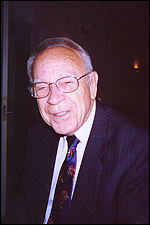
Maurice Hall
“The first to dream”
The place was Yalta on the Black Sea. Heads of the world’s superpowers gathered there in February, 1945—Franklin D. Roosevelt, Winston Churchill, and Joseph Stalin. During his time in Yalta, U. S. President Roosevelt stayed in touch with Washington through shortwave radio transmission. Army Lieutenant Maurice Hall was among the soldiers who had set up that shortwave equipment to be shipped to Yalta for the President’s use. As Lieutenant Hall spent days on the shortwave project, he began to wonder: could not that same shortwave technology be used to spread—not war news, not national news, but—Good News for everyone on earth?
Now fast-forward 30 years. Maurice Hall sat in the Abilene, Texas, living room of Lowell and Earline Perry along with B. E. Davis, George Bridges, Charles Whittle, Ken Ferguson, and Don Crisp. They and other like-minded people envisioned the possibility of using shortwave technology—that same shortwave technology that Maurice had used in wartime—to broadcast the gospel around the world. Would it work? What would it take? Could the resources be found? Who would write the programs? In what languages would they broadcast? Where would a station be built? So many questions!
One early suggestion: build it in the Caribbean. A team of three was dispatched to check out possible sites—a trip that turned out to be fateful. On March 25, 1977, the private airplane they were flying broke apart in midair, killing two World Christian Broadcasting board members, Dr. Lowell Perry and Ken Ferguson, and their French interpreter, Hal Frazier, the administrator of World Radio.
Grieved as they were, surviving board members determined, with God’s help, that they would not be stopped. Plans continued, other sites were explored, and in December, 1979, a 28 hectare plot in Anchor Point, Alaska, was purchased. Preliminary engineering began in 1980, and on July 23, 1983, the new station, KNLS (the “New Life Station”) signed on for the first time. Earliest programs were in Russian and Chinese. English was added later. All of China is covered by this station, as well as all the Pacific Rim countries and most of Russia. We have received responses from listeners in every country of the world.
In 2005 a second transmitter and antenna were completed on the Anchor Point site, so that at present 20 hours of programming are dispatched every day in Chinese, Russian, and International English.
But God keeps on blessing the ministry beyond anyone’s expectations. In addition to the station in Alaska, a new site in Madagascar began broadcasting on Easter Sunday, March 27, 2016. Through its three antennae, programs are broadcast daily throughout Europe and Western Asia, the Middle East, Africa, India, and even across the Atlantic to South America. We have added four new languages: Arabic, Spanish, Portuguese and English with an African sound. With both stations fully functioning, the entire inhabited world is within the sound of our broadcast voice. The world is listening.
In the beginning, writers were scattered all over the U.S. In 1989 a new Programming Center was built and dedicated in Franklin, Tennessee. Four state-of-the-art, soundproofed, climate-controlled recording studios were constructed inside a building that houses offices for all twenty-six permanent staff members. In addition, over 20 more writers from around the world contribute to the broadcast schedule on a part-time basis.
The first president of World Christian Broadcasting was the late Robert E. Scott. He served from 1980 until 1993 when Charles Caudill was named. He served until 2018 when Andy Baker became president.